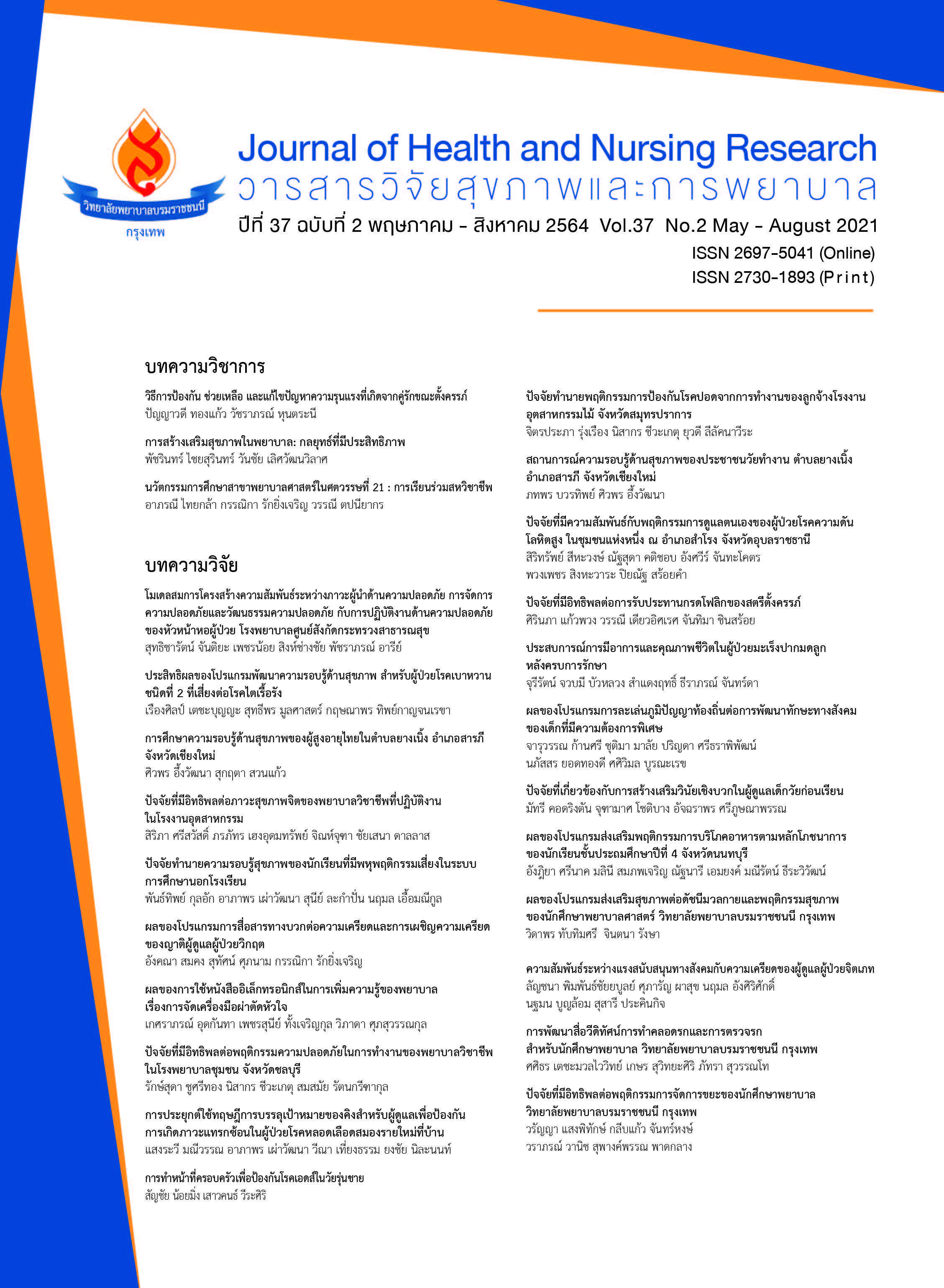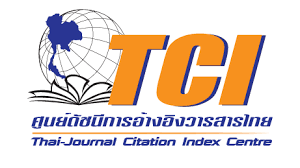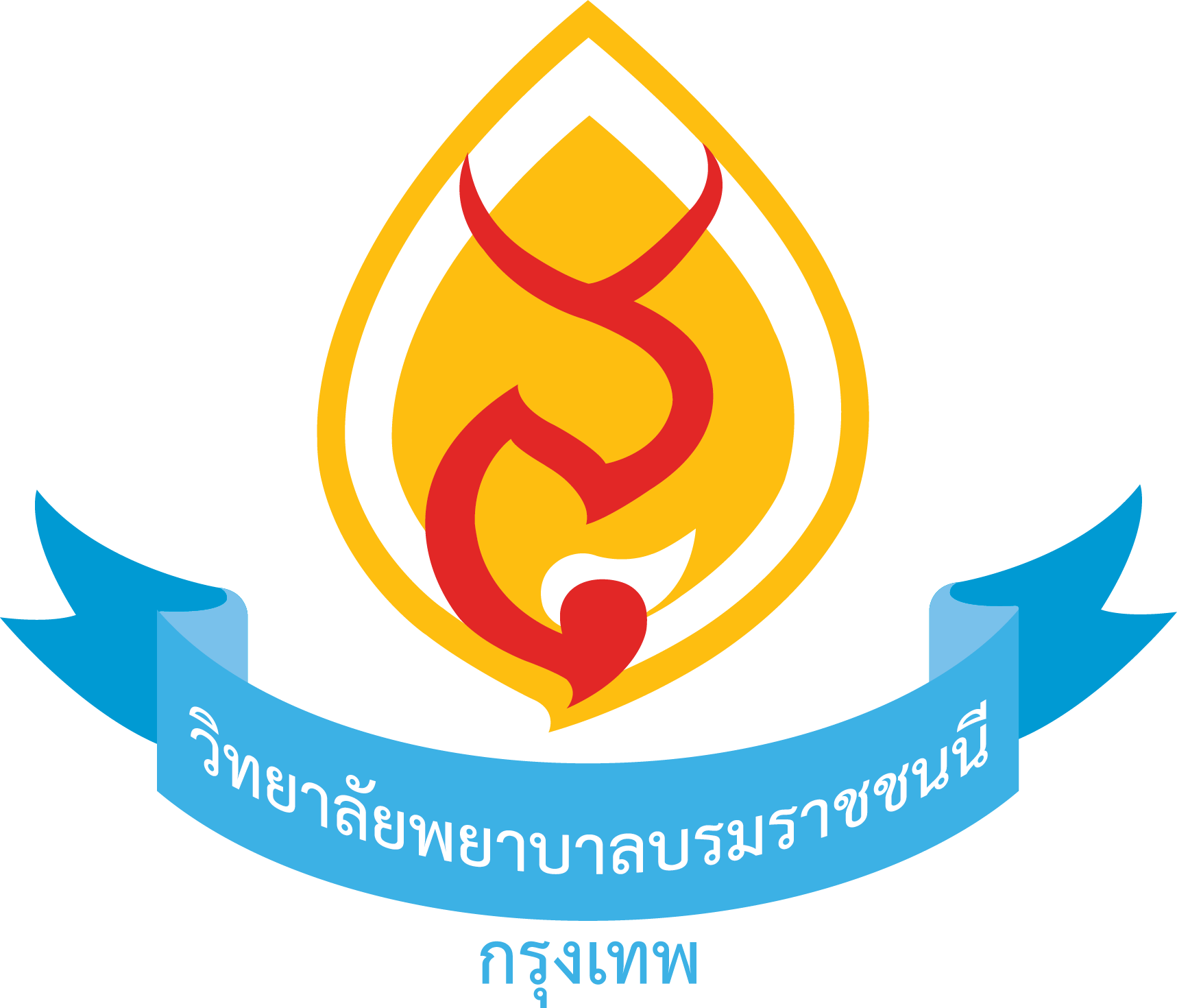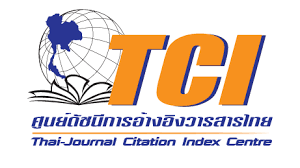การประยุกต์ใช้ทฤษฎีการบรรลุเป้าหมายของคิงสำหรับผู้ดูแลเพื่อป้องกัน การเกิดภาวะแทรกซ้อนในผู้ป่วยโรคหลอดเลือดสมองรายใหม่ที่บ้าน
คำสำคัญ:
โรคหลอดเลือดสมอง, ผู้ดูแลผู้ป่วยโรคหลอดเลือดสมอง, ภาวะแทรกซ้อนจากโรคหลอดเลือดสมองบทคัดย่อ
บทนำ: โรคหลอดเลือดสมองเป็นสาเหตุสำคัญของการเสียชีวิตอันดับ 2 ของโลก จากข้อมูลที่ผ่านมาพบว่า ส่วนใหญ่ผู้ป่วยโรคหลอดเลือดสมองเมื่อกลับบ้านระยะหนึ่งก็ต้องกลับเข้ามารักษาในโรงพยาบาลซ้ำ โดยสาเหตุส่วนใหญ่เกิดจากภาวะแทรกซ้อน วัตถุประสงค์การวิจัย: การวิจัยกึ่งทดลองนี้มีจุดมุ่งหมายเพื่อศึกษาศึกษาผลของโปรแกรมการดูแลผู้ป่วยโรคหลอดเลือดสมองสำหรับผู้ดูแลโดยที่ประยุกต์ใช้ทฤษฎีการบรรลุเป้าหมายของคิงในการป้องกันการเกิดภาวะแทรกซ้อนในผู้ป่วยโรคหลอดเลือดสมองรายใหม่ที่บ้าน ระเบียบวิธีวิจัย: กลุ่มตัวอย่างคือ ผู้ดูแลผู้ป่วยโรคหลอดเลือดสมองที่เป็นผู้ป่วยรายใหม่ซึ่งจะจำหน่ายออกจากหอผู้ป่วย โดยมีระดับความสามารถในการทำกิจวัตรประจำวันของบาร์เทล (The Barthel Activities of Daily Living Index) น้อยกว่า 70 คะแนน และอาศัยอยู่ในกรุงเทพมหานคร จำนวน 50 คน แบ่งออกเป็น 2 กลุ่ม คือ กลุ่มที่เข้าร่วมโปรแกรม จำนวน 25 คน และกลุ่มเปรียบเทียบ จำนวน 25 คน กลุ่มที่เข้าร่วมโปรแกรมจะได้รับการดูแลผู้ป่วยโรคหลอดเลือดสมองที่นำทฤษฎีการบรรลุเป้าหมายของคิงมาประยุกต์ใช้เป็นระยะเวลา 7 สัปดาห์ เก็บรวบรวมข้อมูลเพื่อประเมินพฤติกรรมการป้องกันการเกิดภาวะแทรกซ้อนโดยผู้วิจัย ในระยะก่อนการเข้าร่วมโปรแกรม หลังการเข้าร่วมโปกรแกรมและระยะติดตามผล วิเคราะห์ข้อมูลโดยสถิติ ร้อยละ ค่าเฉลี่ย ส่วนเบี่ยงเบนมาตรฐาน Chi square, Fisher test, Wilcoxon Singed Ranks Tests และ Mann Whitney Test ผลการวิจัย: ผลการวิจัยพบว่า เมื่อสิ้นสุดการทดลองคะแนนเฉลี่ยพฤติกรรมการป้องกันการเกิดภาวะแทรกซ้อนของกลุ่มที่เข้าร่วมโปรแกรมแตกต่างกับกลุ่มที่ไม่ได้เข้าร่วมโปรแกรม ทั้งระยะหลังเข้าร่วมโปรแกรมและระยะติดตามผลอย่างมีนัยสำคัญทางสถิติ (p< .05) สรุปผล: ผลการศึกษาแสดงให้เห็นว่าโปรแกรมการการดูแลผู้ป่วยโรคหลอดเลือดสมองที่ประยุกต์ใช้ทฤษฎีการบรรลุเป้าหมายของคิงสามารถเพิ่มพฤติกรรมการดูแลผู้ป่วยโรคหลอดเลือดสมองที่ถูกวิธี มีความต่อเนื่อง และสามารถป้องกันการเกิดภาวะแทรกซ้อนได้ ข้อเสนอแนะ: ควรมีการนำโปรแกรมการพยาบาลที่บ้านโดยประยุกต์ใช้ทฤษฎีการบรรลุเป้าหมายของคิงร่วมกับการมีส่วนร่วมของผู้ดูแล ไปใช้ในการส่งเสริมพฤติกรรมการดูแลผู้ป่วยโรคหลอดเลือดสมอง เพื่อให้ผู้ดูแลมีพฤติกรรมการดูแลผู้ป่วยโรคหลอดเลือดสมองได้อย่างเหมาะสม ต่อเนื่องและสามารถป้องกันการเกิดภาวะแทรกซ้อนได้
Downloads
ดาวน์โหลด
เผยแพร่แล้ว
รูปแบบการอ้างอิง
ฉบับ
ประเภทบทความ
สัญญาอนุญาต
บทความที่ได้รับการตีพิมพ์ เป็นลิขสิทธิ์ของวารสารวิจัยสุขภาพและการพยาบาล (วิทยาลัยพยาบาลบรมราชชนนี กรุงเทพ) ไม่สามารถนำไปตีพิมพ์ซ้ำในวารสารฉบับอื่น


















